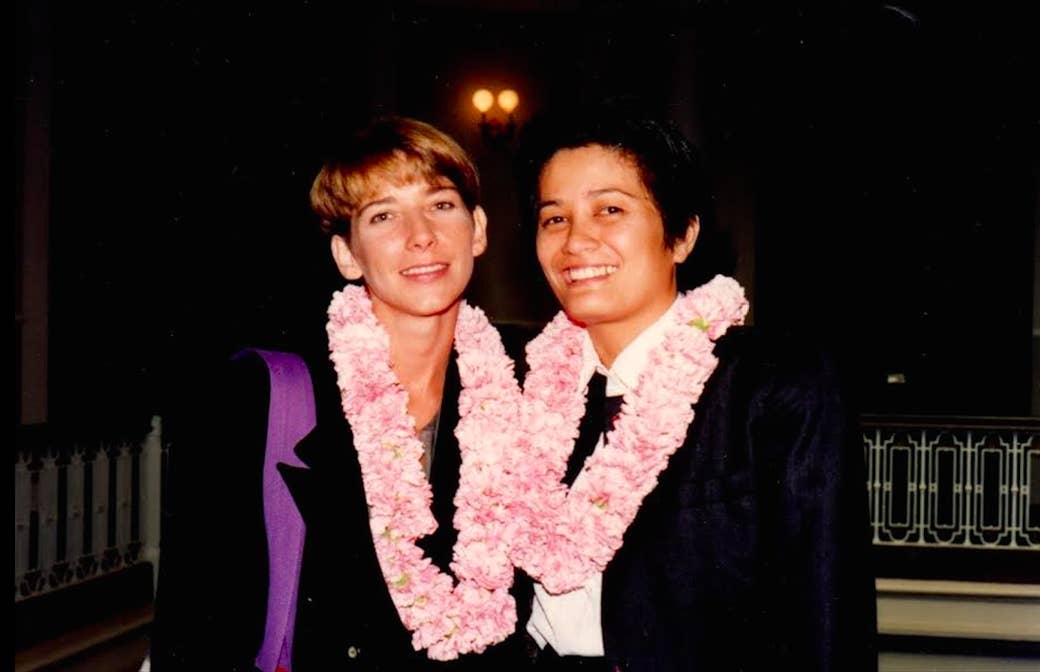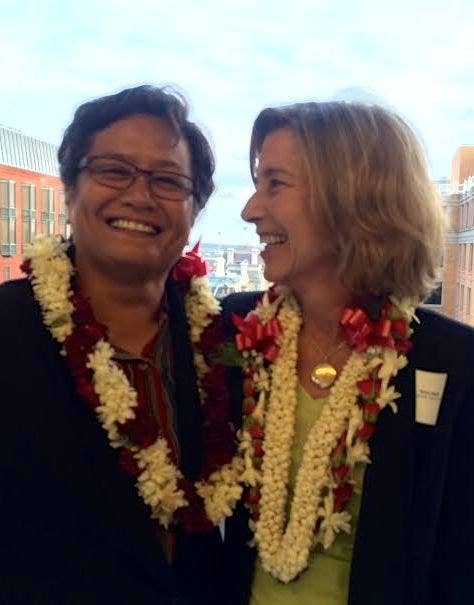
Ninia Baehr and Genora Dancel were standing among a jittery, excited crowd Monday evening in a law office two blocks from the White House. The U.S. Supreme Court would be hearing arguments in the morning about whether same-sex couples have a constitutional right to marry. The assembly was mostly same-sex couples who, like them, had been plaintiffs in state lawsuits fighting for marriage rights.
Southern drawls and cowboy hats, plaid flannel shirts, Midwestern vowels and California tans, and angular eyewear being sported by New England gays displayed how far these fighters had come to watch a national showdown on marriage equality. But Baehr and Dancel had traveled particularly far and waited a particularly long time for this — almost 25 years — as it was their lawsuit in Hawaii in the 1990s that first made it clear that winning marriage equality in court was even possible.
Evan Wolfson, founder of Freedom to Marry, which threw the reception and had a hand in many of the cases, addressed the group only briefly. "When people ask which is my favorite case, I say I love all my children — but I would like to give a special mention to our plaintiffs from Hawaii."

Filed along with two other couples, Baehr and Dancel's case was the first legal victory in the country for same-sex couples seeking marriage rights, sparking a chain reaction of litigation. And Monday — with the highest court hours from hearing arguments on cases in Kentucky, Michigan, Ohio, and Tennessee — the pair was humble about their role.
“We didn't know where it was going to go,” Dancel said.
Yet there they were, listening to President Obama's senior adviser Valerie Jarrett address the crowd and declare, "No matter who you love, you ought to have equal rights."
But Baehr and Dancel’s lawsuit did not start in a Washington, D.C., law office or within any hall of power. They were not vetted and groomed to be media-genic, like many marriage plaintiffs these days. And the advocacy powerhouses known to represent clients in landmark LGBT civil rights cases did not sanction the strategy — in fact, those groups refused to take the case. This is how their love, and lawsuit, came to be.
The seeds of Baehr v. Lewin were planted when Baehr first saw Dancel in a Honolulu parking lot.
“This beautiful woman came out, and my mom said to me, ‘That is my friend Genora, and I think she is a lesbian,’” Baehr said in a phone call this month with BuzzFeed News.
A few days later, Baehr coaxed herself into dropping in at the PBS station where Dancel worked. They chatted next to a Big Bird statue in the lobby. “We set a date,” Baehr said. “It lasted for nine hours, and we fell in love.”
In the early 1990s, however, marriage rights for same-sex couples weren’t on the menu, politically speaking. “It was during a time where gays in the military was the main subject, if you had to talk about gay happenings or news,” said Dancel.
“But," she continued, "I wanted marriage."
So Dancel proposed.
“Genora had given me a ring, and I said, ‘Yes, I will marry you,’” said Baehr, picking up the thread where Dancel left off. “But at first, it was for emotional reasons.” Obtaining legal recognition didn’t seem necessary until Baehr had an ear infection that landed her in the emergency room.
“I was working a couple of jobs, and I had medical insurance and Ninia did not,” Dancel remembered. Married couples, of course, can share insurance plans.
Baehr got in touch with a straight civil-rights lawyer named Dan Foley.
Foley invited the couple to join two other couples at the Hawaii Department of Health to apply for a marriage license — the next morning. If they applied and were refused, they would have the basis for a lawsuit.
Asking for a marriage license was a scary decision.
“My whole life flashed in front of me,” Dancel said.
She knew she was a lesbian when she was 5 years old, but had never been part of the gay community — had never even entered a gay bar. Still, she recalled, “I had been discriminated against and was living as a second-class citizen. All of that, emotionally, came to mind. For me it was a no-brainer decision. This was something I had to fight for, and I had to do my part. I had actually found someone I wanted to spend the rest of my life with. It was not hard to call back and say, ‘I will be there tomorrow. Count me in.’”
TV camera crews were at outside the building when they arrived on on Dec. 17, 1991.
“Irene was the clerk at the marriage licensing office,” Dancel recalled. “She took our application, and she said she couldn’t give us our license that day.”
“But there was no institutional support for us at that time,” Baehr said about suddenly becoming public figures for gay rights, “especially for Genora. It was such a scary thing — she came out on television.”
This was not exactly a popular strategy.
“There were lots of people — especially on the mainland and people who were fairly politically savvy in the gay community who considered themselves activists — who would say everything from 'You have no chance of winning and could set a bad precedent' to an even bigger argument,” Baehr says of resistance to their marriage case, even within the LGBT movement.
Freedom to Marry founder Wolfson founder was working for Lambda Legal at the time. Though the group had declined to represent the couples officially, Lambda Legal let Wolfson help on the side.
“At that point in the movement, activists were very divided over the freedom to marry,” Wolfson told BuzzFeed News. “There were two camps. There was an ideological camp and what I’ll call a strategic camp. In the ideological camp, they saw marriage as a flawed institution, patriarchal, oppressive to women, and not something we wanted. And the other camp thought we should not be fighting for assimilation or emulating heterosexuals, but should be liberationists. They believed the movement should be fighting to create something new.”
Furthermore, times were particularly hard for LGBT activists.
“It was a very small movement, beleaguered from battling HIV and AIDS and a hostile Reagan administration,” Wolfson said. “People who didn’t have that ideological opposition argued that fighting for marriage would be too difficult, premature, or risky at a time that it would set us back. I was a minority voice and sometimes a lone voice that we should have a strategy for moving marriage forward.”
The plaintiffs were a “ragtag group,” not carefully chosen poster children.
“This was not a strategy or a plan hatched by the mainstream movement,” said Baehr. “This was a ragtag group of people who were tired of being second-class citizens. The plaintiffs and their supporters were working-class people of color, lesbians, transgender people, drag queens, people in bars. It was not the white elite of the gay movement. It was not the rich lawyers.”
“By the 1990s, because of the AIDS crisis and who had the money and contacts and political savvy to mobilize, a lot of what we did see was gay male culture,” Baehr said. “That was a horrific crisis, and I can understand that.”
In April 1991, the Hawaii Department of Health officially declined to issue marriage licenses to the three couples, which led them — represented by Foley — to file a lawsuit asking a trial court to recognize their marriage applications. The judge in that case refused, as other courts had with other cases over the previous two decades.
They appealed.
It was then, in 1993, when the Hawaii Supreme Court made a pivotal decision in the LGBT rights movement: The court found the state must provide a justification for refusing the marriage license — using strict scrutiny, the most stringent standard for establishing governmental interest — and they sent it back to the lower court.
“They weren’t going to rubber-stamp the denial,” Wolfson exclaimed. “For the first time, we were given our day in court. We knew this wasn’t about one case and wasn’t going to be about Hawaii. This was going to be a national conversation about the freedom to marry. And people across the country and, indeed, around the world could fight for freedom to marry — and we did have a chance at winning.”
So, the lawyers prepared their case.
But the case was not actually unique.
“It’s not that we made some brilliant new argument in Hawaii that we hadn’t thought of in the early '70s,” Wolfson said. “And when we go before the Supreme Court today, it’s not that we are making some brilliant argument that we hadn’t thought of before. It’s that the courts and the country are ready to see what the constitution has always commanded and how it applies equally to loving and committed gay couples.”
As of Tuesday, 35 states have full marriage equality — while the remaining states have a patchwork of marriage rights and marriage recognition. Others are entangled in legal challenges.
Why did the first wave of marriage lawsuits that started in the 1970s fail while the second generation of cases — which began in Hawaii — begin a winning streak?
“What came between the two was AIDS,” Wolfson said. “AIDS shattered the silence of gay people’s lives and helped people see gay people are rounded people who love others, fight for loved ones, who grieve losses, and are harmed by exclusion or denial. It showed people how vulnerable gay people are, and it transformed our movement.”
On Dec. 3, 1996, Judge Kevin Chang ruled that the state of Hawaii had failed to show a compelling interest in denying same-sex couples the ability to marry. The judge put the decision on hold pending a possible appeal, but this was the first landmark victory for same-sex marriage.
Then came the backlash.
“People used to ask us, ‘Are you afraid of the backlash?’ and we, not being sophisticated, would say, ‘No,’” said Baehr.
As Baehr and Dancel’s case moved through the courts, Congress introduced and passed the Defense of Marriage Act, or DOMA, which purports to allow states to refuse recognition of same-sex couples’ marriages.
“Standing outside the Capitol Building the day before President Clinton signed DOMA was wrenching,” Baehr said. “Here is something bad that happened because of what we did.”
Similarly, anti-gay groups poured money into Hawaii, successfully passing a constitutional amendment at the ballot box in 1998 that barred same-sex marriage.
A court found that Hawaii’s constitutional amendment nullified Baehr and Dancel’s court victory. But that was just the beginning: States across the country passed similar constitutional amendments over the following decade.
“The victory was snatched away politically,” Wolfson said. “But we broke through the silence.”
Baehr and Dancel are back in Washington.
The couple did eventually get married, but not to each other. Baehr married in Montana, and Dancel married in Hawaii.
“In my home state, I went back to apply for license,” Dancel said. “It was the same clerk — and she remembered me — and we hugged. She was more than happy to give me my license the second time, 23 years later.”
Back in Washington, D.C., as the Supreme Court hears arguments in a case widely expected to come down in favor of the gay plaintiffs, Dancled added, “I would always I tell Ninia that this was going to happen in our lifetime. I had no doubt.”
